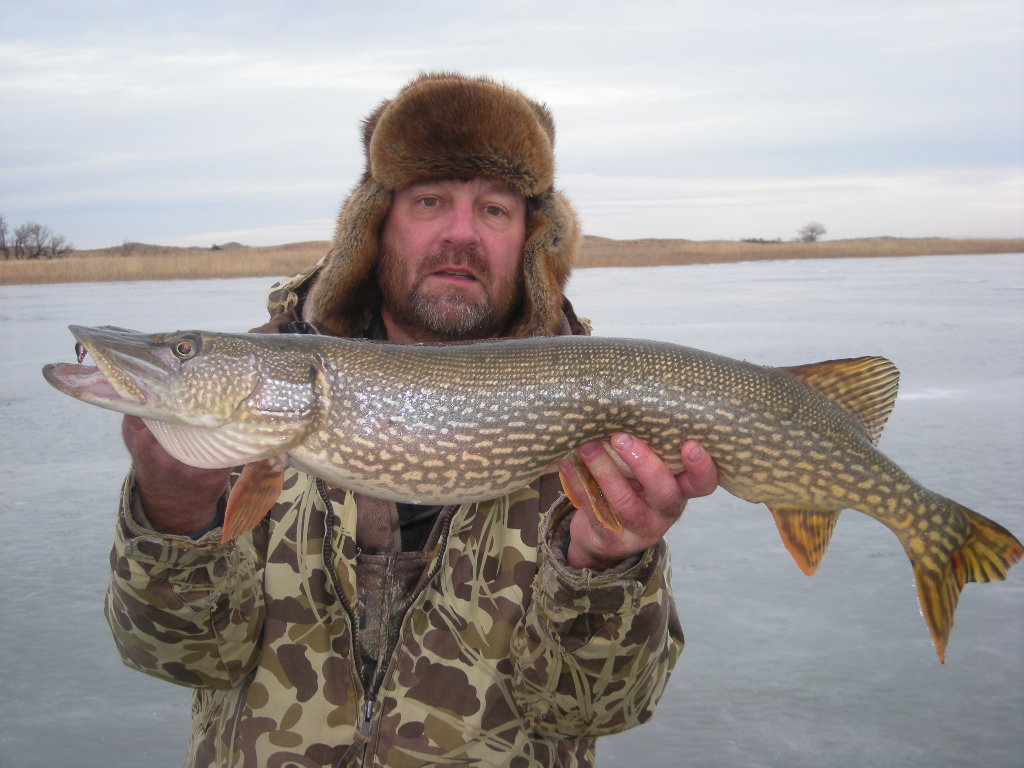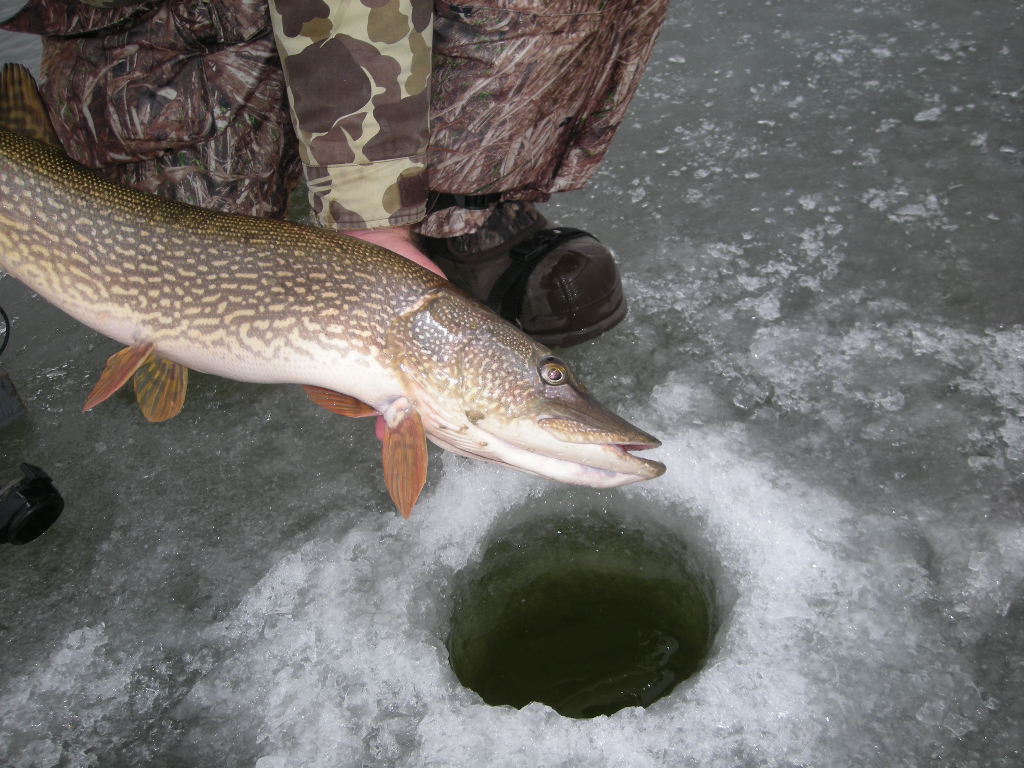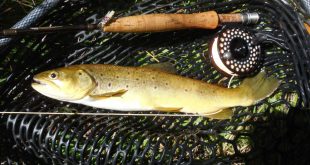I was browsing the Omaha World Herald yesterday and was pleasantly surprised to see a full-color picture of an ice angler holding a nice northern pike. What was really surprising about this was that this picture and the accompanying story were not in the outdoor section or even sports section of the newspaper. They were on the back page of the front section! Here is the story, Report details killing tendencies of nature’s most lethal predator.
As you can imagine, the headline caught my attention and I read the whole story. Apparently, the World Herald picked up a story that originally ran in the Washington Post. The story reviewed some work that recently was published in Science magazine, work done by a geography professor and reported in the Washington Post by a biology professor. Now I realize I risk mis-characterizing the research by not reading the original paper, or even the story in Science, but I do know what I and many others read in the World Herald and I found it to be quite interesting.
Basically, the premise was that humans are “super predators”. I do not think that is debatable, but that conclusion was reached because,
Humans, the study found, prey on other large carnivores at nine times the rate that those large carnivores prey on one another. And we target adults in their reproductive prime much more than is natural in the animal kingdom.
The World Herald/Washington Post story went on to say,
“Our impacts are as extreme as our behavior and the planet bears the burden of our predatory dominance.”
This imbalance is most pronounced in fishing, Danmont and his colleagues explained during a teleconference held by Science.
Humans go after mature adult fish at a rate 14 times higher than any natural predator.
That last statement is true, I have even blogged about it, have frequently mentioned that anglers tend to select for big fish. I can even think of another peer-reviewed, science publication in particular that came to that same conclusion, How Big?.
That is why I have been a huge proponent of catch & release of big fish, big fish regardless of species! “Selective harvest” is the term that has been coined to describe a different philosophy of harvesting fish, a philosophy of only keeping enough fish for a meal of fresh fish now and then, not filling the freezer. It is a philosophy of selectively harvesting those species and sizes of fish that can withstand the harvest–in most cases small- and medium-size fish, panfish in most fisheries, but abundant, predator fish in others. Large fish are hard to catch not because they are so smart, but because they are so rare. For that reason, large fish of any species, even panfish, are the best candidates for release.
The researchers quoted in the newspaper story even suggested the same thing:
“Catching predominantly small, juvenile fish is actually the fishing pattern that I have observed in many small-scale African fisheries over the past 30 years, and they are highly productive and sustainable.” Kolding told the Washington Post.
For a long, long time, anglers have had this idea that we need to turn the “little ones” loose so they have a chance to grow up. Actually, I would much rather see anglers harvesting little fish of every species while turning the big ones loose! I suspect I will spend the rest of my career trying to change angler’s thinking on that. Unfortunately, anglers tend to select for big fish, and they tend to harvest fish “from the top, down”–they keep the largest ones first, and when those are gone they keep those just a little bit smaller, and keep working their way down the length distribution until all that is left is little ones that no one wants to clean. At that point anglers announce that they “need to let the little ones grow up” without realizing that as soon as those little ones reach a size large enough for someone to fillet, they go home in the back of a pickup. So, they keep releasing the “little ones” but never seem to see more “big ones” because they never get a chance to grow bigger once they reach that minimum size where someone wants to harvest them. If they would learn to harvest the small- and medium-size fish, where allowed, while releasing the big ones, they might be surprised at the result.
As a matter of fact, fisheries management in many sport fisheries has evolved in that direction. The quality of fishing is important to anglers and anglers desire to have at least the opportunity to catch some big fish. Modern fisheries management includes many bag and length limits designed to reduce harvest and protect larger fish in order to develop and maintain quality fisheries.
That is something that was not mentioned by any of the researchers quoted in the newspaper story. At least they recognized that we are part of nature, we are in fact predators (my eyes are in front!). However, they did not mention that we also are stewards, caretakers of those fish & wildlife resources. Hunters, anglers and trappers have been and continue to be THE original conservationists (North American Model of Conservation I, North American Model of Conservation II). Regulated sport fishing, sport hunting and trapping have not been a detriment to our ecosystems or fish & wildlife, and have in fact funded many fish & wildlife and habitat success stories!
The premise that us “super predators” are harvesting too many big fish, or big predators, may be true in some subsistence situations, but how many of us live like that in today’s modern world? Our sport harvest of fish & game, big fish and trophy game animals included, are carefully regulated, and in many cases accomplish the very things the newspaper story says we should be doing. I have already stated that modern fisheries management is regulating harvest of large, adult fish. Harvest strategies for many game animals are also directed towards the animals, in many cases the sexes, that are most expendable. If populations need to be re-built and protected, reproducing individuals are protected. That is why we can harvest only rooster pheasants, that is why more buck deer are taken than does unless we need to reduce deer populations. So, whether university researchers or journalists realize it or not, much of modern fish & wildlife management is already doing the things that newspaper article scolds us for not doing. As a matter of fact, we have known this since Bible times!
If you come across a bird’s nest beside the road, either in a tree or on the ground, and the mother is sitting on the young or on the eggs, do not take the mother with the young. 7 You may take the young, but be sure to let the mother go, so that it may go well with you and you may have a long life.–Deuteronomy 22:6, New International Version
While I am on my soapbox, let me comment on a few other things you have heard in the news recently. . . .
I have heard some take shots at the “sport” of hunting or fishing. For various reasons their opinions are that we should not be hunting or fishing for any fish or game for sporting reasons; it would be acceptable to take fish & game for food if we need the food, but we should not be doing it for “sporting” reasons. What? You would rather that I fish with nets and dynamite? Or that I take game by punt and battery guns, or spot-lighting? You would rather that I sold what I harvested? No, at least on this continent we have “evolved” beyond that and our fish & wildlife populations have benefited from it. We believe in limiting our harvest by limiting our methods of take to what is more “sporting”. Yes, it is a sport, there are skills and techniques that must be mastered in order to be successful. Yes, we do it because we enjoy it, but we also enjoy the fruits of the harvest on our tables too. Yes, we are hunting and fishing for sport, we enjoy that recreation because some of us know exactly who we are–predators. Maybe we are “super predators” because we are the only ones to handicap ourselves in the pursuit of that prey?
I have always said that a “trophy” is what you make of it. Recently, there have been many disparaging remarks thrown the way of “trophy” hunters or “trophy” anglers. Curiously, those who are quick to criticize us for our “trophies” have no idea the amount of time or skills invested in those successes. Those successes and special times on the water or in the field should be remembered, should be celebrated, should be “trophy-ized”! And I ain’t about to start apologizing for it!
Let me dial it back a bit and wind up my ramblings. I mentioned the photo of the grinning ice angler with his trophy pike that went with the newspaper story. Who says that fish was not released?


 Nebraskaland Magazine
Nebraskaland Magazine



